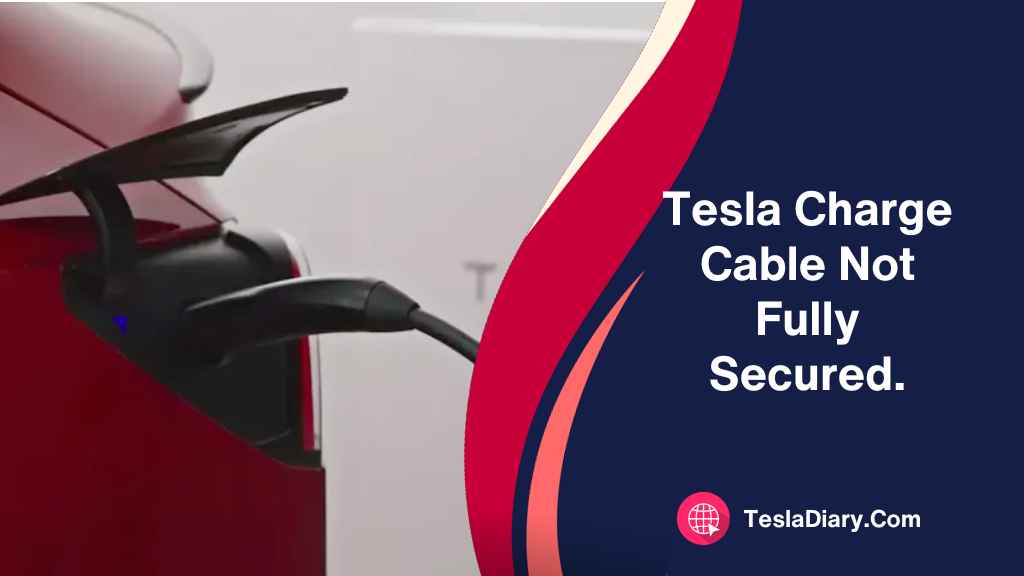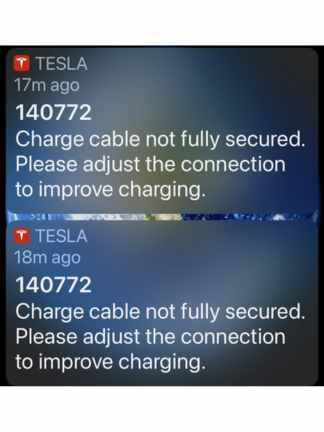Picture this: you’ve just arrived home after a long day, and your Tesla’s battery gauge is inching closer to the dreaded “low” mark.
It’s time to plug in and recharge, but just as you connect the charging cable, a chilling error message flashes across your Tesla’s sleek touchscreen: “Charge Cable Not Fully Secured.”
Panic sets in. Is your beloved electric vehicle about to leave you stranded?
Fear not, fellow Tesla enthusiast. We’re here to unravel the mysteries of this vexing issue and arm you with the knowledge and solutions to conquer it.
In this in-depth guide, we’ll dissect the common causes behind the error and provide you with step-by-step solutions to ensure your charging experience is not only secure but also hassle-free.

So, let’s roll up our sleeves and delve into the world of Tesla charging mysteries – and emerge victorious!
Understanding & Fixing the “Charge Cable Not Fully Secured” Error
Before we dive into the potential reasons behind this error message, let’s first understand what it means.
When you connect your Tesla to a charging station, the vehicle should securely lock onto the charging cable, ensuring a safe and efficient charge.
However, if there is an issue with the connection, you may see the error message “Charge Cable Not Fully Secured. Please adjust the connection to improve charging.” displayed on your Tesla’s touchscreen.

This error message is not just a mere inconvenience; it is a vital safety feature designed to alert you to potential issues with the charging process.
It indicates that the charging cable has not properly engaged with the vehicle’s charging port, which could lead to a failed charge or, in extreme cases, unsafe conditions. Therefore, it is essential to address this error promptly and correctly.
Now, let’s explore in greater detail the most common reasons behind the charging cable error and provide comprehensive solutions for each:
How to Fix Charge Cable Not Fully Secured Error in Tesla?
To fix the error, you need to
- Ensure no physical obstructions between the charge port and the connector.
- Ensure proper alignment of the connector to the port.
- Make sure the connectors are intact and clean.
- Try rebooting the vehicle’s system, if not solved yet.
- Try turning off the electric supply to the wall connector and turning it on again.
- Use a compatible charging cable and connector.
1. Physical Obstruction
Sometimes, foreign objects, ice, or debris can accumulate in the charging port, preventing the cable from making a secure connection. This will cause the Tesla charging cable to not work as expected.
Solution: To address this issue, follow these steps:
- Inspect the charging port for any obstructions and clear them if necessary. Use a flashlight to get a better view of the inside of the port.
- Ensure there is nothing blocking the cable’s path when you attempt to insert it.
- If ice is the culprit, you may need to wait for it to melt before attempting to connect the cable.
- If there is dust, use a brush to get rid of it.
2. Misalignment
Proper alignment is crucial for a secure connection. If the cable and the charging port are not aligned correctly, the connection may not engage.
Solution: To ensure proper alignment and successful connection:
- Carefully align the charging cable and the port on your Tesla before attempting to connect.
- Make sure they are perfectly aligned to ensure a secure connection.
- Pay close attention to the orientation and angle of the cable and port to prevent any misalignment.
- Also, push the connector firmly inside the port for a good connection.
3. Damaged Cable
A damaged charging cable with frayed wires, bent connectors, or other physical defects may not establish a secure connection.
Solution: Here’s what you should do if you suspect a damaged cable:
- Examine the charging cable for any visible damage, including frayed wires, bent or corroded connectors, or cuts in the cable insulation.
- If you find any damage, it’s essential to replace the cable with a new, undamaged one.
- Avoid using damaged cables, as they can pose safety risks and potentially damage your Tesla’s charging port.
4. Dirty or Corroded Connectors
Over time, dust, dirt, or corrosion can accumulate on the connectors of the charging cable or the vehicle’s charging port, preventing a proper connection.
Solution: To maintain clean and corrosion-free connectors, follow these steps:
- Carefully clean both the connectors on the charging cable and the port on your Tesla using a soft cloth or an appropriate cleaning solution.
- Ensure that all debris, dirt, and corrosion are thoroughly removed.
- Regularly inspect and clean the connectors to prevent future issues.
5. Software Issue
Occasionally, a software glitch in the Tesla’s onboard computer system can trigger this error message.
Solution: To resolve software-related issues, follow these steps:
- Try rebooting the vehicle’s system by holding down both steering wheel buttons (scroll wheels) for approximately 10 seconds until the Tesla logo appears on the touchscreen.
- After the reboot, attempt to connect the charging cable again to see if the error persists.
- Also, turn off the electricity to the wall connector using the circuit breaker and turn it on before trying to charge the vehicle again.
- If the error continues, consider checking for any available software updates for your Tesla, as these updates may include bug fixes related to charging.
6. Charging Cable Compatibility
It’s important to use a compatible charging cable with your Tesla. Some third-party charging cables may not work reliably with Tesla vehicles.
Solution: To ensure compatibility and a reliable connection, consider the following:
- Use the official Tesla charging cable provided with your vehicle, as it is designed and tested for compatibility.
- If you need to purchase a new charging cable, make sure it is confirmed to be compatible with your specific Tesla model and charging hardware.
- Avoid using low-quality or unverified third-party cables, as they may not provide a secure connection and could potentially damage your vehicle.
7. Faulty Charging Port
While rare, the issue may be with the vehicle’s charging port itself, which could require professional inspection and repair.
Solution: If none of the above solutions work and you continue to encounter the error:
- Contact Tesla customer support or visit a Tesla service center to schedule an inspection and potential repair of the charging port.
- A certified technician will be able to diagnose any issues with the charging port and take the necessary steps to resolve them.
Conclusion
The Tesla charging cable not working can be a source of frustration for Tesla owners, but it’s typically a solvable problem with the right approach.
By following the troubleshooting steps outlined in this comprehensive guide, you can address the issue and get your Tesla back to charging smoothly and efficiently.
Remember that safety should always be a top priority when dealing with EV charging. If you’re unsure about any aspect of the charging process or encounter persistent issues that you can’t resolve yourself, don’t hesitate to seek assistance from Tesla’s customer support or a certified service technician.
They have the expertise and tools to diagnose and rectify any issues, ensuring your Tesla remains a reliable and environmentally friendly mode of transportation.

